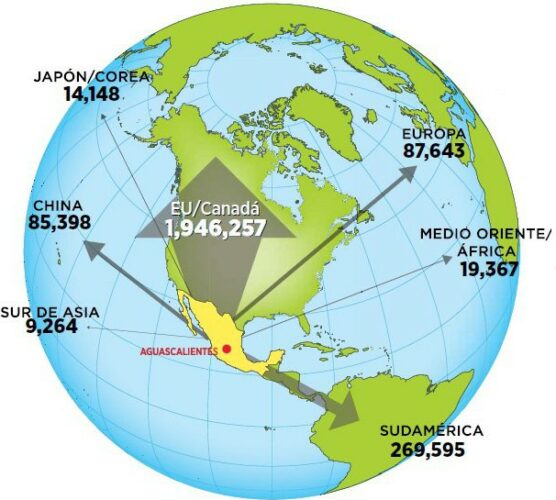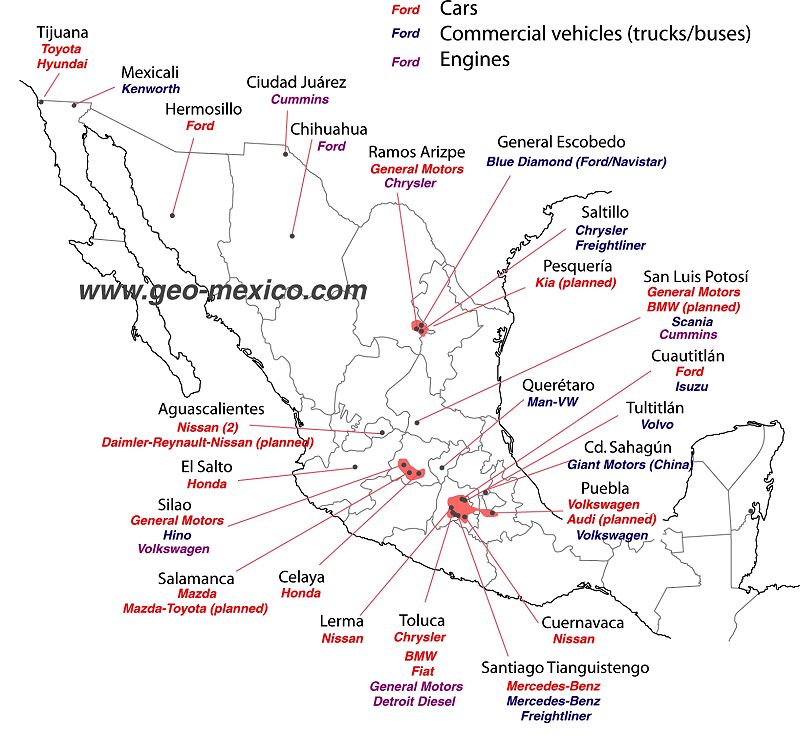Mexico is one of the world’s “Top Ten” countries for vehicle production and for vehicle exports. In 2014, it has overtaken Brazil to become the world’s 7th largest vehicle producer and fourth largest exporter. 80% of Mexico’s production of around 3.3 million vehicles in 2014 were made for export. The trade surplus generated by the automotive sector exceeded 47 billion dollars in 2014.
The industry attracts large amounts of Foreign Direct Investment (FDI). Vehicle assembly plants provide around 65,000 jobs, with a further 85,000 employed in distributorships nationwide and a whopping 450,000 employed in the autoparts sector.
The autoparts sector along produces items worth $80 billion/year, but Mexico also has to import components made elsewhere worth a further $35 billion. Clearly, this offers some opportunities for additional investment aimed at import substitution. Most of the opportunities are likely to be for Tier 2 companies. It is customary to divide the autoparts sector into three distinct parts: OEM, Tier 1 and Tier 2. OEM (Original equipment manufacturer) refers to companies that make a final product for the consumer marketplace (eg Volkswagen). Tier 1 companies are direct suppliers of components to OEMs, and Tier 2 companies are the key suppliers of parts or raw materials to Tier 1 suppliers.
Total production in 2014 topped the 3 million barrier, and the Mexican Automotive Industry Association (AMIA) believes production could reach 4 million units by 2015 and 5 million by 2020.According to AMIA, the best selling models on the domestic market are the Aveo (GM), Jetta (VW), Versa and Tsuru (both Nissan).
There are about 30 vehicle assembly plants in Mexico, manufacturing many brands of cars and trucks (see map). In addition, there are 1200 firms specializing in making parts for vehicles.
Vehicle manufacturing firms that have announced or confirmed major new investments during 2014 include:
- Chrysler – 1.25 billion dollars to expand its assembly plant in Saltillo and manufacture a new line of Tigershark engines.
- Nissan – to open its second plant in Aguascalientes.
- Mazda – an additional 120 million dollars for its plant in Salamanca (Guanajuato), where it will manufacture several Mazda models as well as one Toyota model.
- GM – investments worth 690 million dollars, divided between its plants in Silao (Guanajuato), San Luis Potosí and Toluca (State of México).
- Audi – about to open a 1.3-billion-dollar plant in San Jose Chiapa, near Puebla.
- VW – 700 million dollars investment to adapt production lines in Puebla to produce its redesigned Golf hatchback.
- Kia – plans to build a $1 billion vehicle assembly plant at Pesquería in the state of Nuevo Leon (scheduled to open in 2016) to produce up to 300,000 vehicles a year. The new plant is expected to generate a further 1.5 billion dollars in investment from firms seeking to join Kia’s supply chain.
This map is an updated version of the map we included in Where are Mexico’s vehicle assembly plants located? (2011).
As the map shows, certain areas of Mexico have attracted more investment in vehicle assembly plants than other areas. The two largest existing concentrations are focused on Toluca in the State of México, and on Saltillo-Ramos Arizpe in northern Mexico. However, the fastest growing cluster is in the central state of Guanajuato.
Virtual visit to the Chrysler plant in Saltillo (video, no commentary):
For a series of discussion questions related to this map and the vehicle assembly industry, see our earlier post – Where are Mexico’s vehicle assembly plants located?
Related posts:
- Which company produces the most motor vehicles in Mexico? (Dec 2012]
- Mexico’s vibrant autoparts sector ( Sept 2011)
- Why has Mexico become one of the world’s top ten vehicle-making countries? (Sept 2011)
- Rapid growth in Mexico’s vehicle manufacturing and assembly sector. (Sept 2012)
- Globalization: Mexico exports almost all motor vehicles it produces, but imports new cars


Sorry, the comment form is closed at this time.